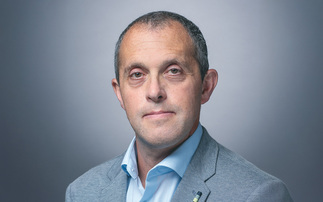Environmental pressures, economic growth and concerns over energy security are already driving the rapid development of energy alternatives for the global marketplace
New energy is the kind of investment proposition that remains niche for years until some event triggers sudden demand for technologies most people didn't know existed. Those investors who had vision and commitment many years back see their relatively modest downpayment pay handsome dividends, and people call them lucky.
But even intuitive research shows that environmental pressures, economic growth and concerns over energy security and reliability are already driving the rapid development of energy alternatives for a global market. These technologies are no longer the stuff of science fiction or green activists' dreams. Some of the biggest companies in the world are quietly incubating what they believe will be the energy sources and systems of the near future.
The power blackouts across California in 2001, those that put 50 million people in Canada and the north east of the US in the dark last year, and smaller incidents in the UK and Continental Europe recently have highlighted the need for greater investment in modern energy technology. But what is out there and who knows about it?
Wind and solar sources are well known alternatives but there are other applications like natural gas power and fuel cells, which combine hydrogen and oxygen in an electrochemical process to generate electricity, that are increasingly deployed. Within fuel cell development, there are various distinct types, such as direct methanol, molten carbonate, solid oxide, phosphoric acid or Proton Exchange Membrane (PEM), all of which best suit different applications.
For a while, during the technology boom at the end of the 1990s, interest in the commercialisation of new energy technologies soared. Investment banks launched new energy funds, analysts covered far reaches of the nascent industry and companies showing any promise were rapidly floated. Investors had a strong appetite for this kind of risk but when the technology bubble burst in 2001, their enthusiasm evaporated into thin air.
One asset management company has stuck with the sector through thick and thin. In 2000, Merrill Lynch spun off a new energy portfolio from its other energy and mining funds. Manager Robin Batchelor, with a background in mining and petroleum geology, listened to oil companies talk of the growing market in alternative energies.
"Clients were also asking about the renewable energy stocks we were holding so we launched the ML New Energy Technology Trust in 2000, followed by the Luxembourg domiciled MLIIF New Energy Fund in 2001," he said. "There was no benchmark telling us what to buy and analyst coverage had withered away so we did original research at the trade fairs and directories to find out who was doing what."
Together with his colleague Poppy Buxton he now manages the $150m, investing in four sub-sectors: renewable energy, automotive and onsite power generation, energy storage and enabling energy technologies.
Batchelor feels the drivers for growth in these areas are more compelling than ever, with environmental pressure remaining the strongest. After global policy events like the Kyoto Protocol, which aims to stabilise and then reduce greenhouse gas emissions, many government delegates returned home determined to implement policy changes, often in favour of renewable energy.
In the UK, it became law that by 2010, electricity providers must produce 10% of their power from renewable sources. The first fuel-cell-powered bus was delivered to the London Transport Authority in December last year and entered service in January. "Environmental pressure has quickly translated into government regulation and that is providing an investment backdrop for utilities and companies to start generating renewable energy," says Batchelor. "That is a major long-term driver and we don't see any reason for it to diminish."
Government responses vary, of course. Denmark and Germany are very proactive on environmental issues and that is reflected in the development of the industry and sales opportunities in those countries. The US is not. The current administration under president George Bush openly holds the view that making environmentally positive changes is an additional economic burden that would make US industry less competitive.
However, Batchelor says, the administration is increasingly interested in energy security, since more than 50% of the country's energy is imported, much of it from the Middle East. "Using less polluting resources is increasingly attractive to them, not because it is less polluting but because it diversifies their energy supply," he adds. "So they are arriving at the same result, but through a different thought process."
He also notes that US energy demand is rising, driven primarily by transportation rather than industrial growth. The penetration rate of US cars is still increasing as each family now has two cars or more, where before it had one. And each vehicle tends to be larger as people chose big 4x4s or recreational vehicles over smaller, energy efficient cars. "The government acknowledges that trend but to curb additional demand is a political hot potato," he says. "So it is looking at technologies to make vehicles more efficient such as natural gas and hybrid electric vehicles or, further out, fuel cells, which are less polluting and twice as efficient as the internal combustion engine."
Government statements indicate that reliability of energy supply is another key concern. As people get used to more electrically powered goods from televisions to personal computers or mobile phones, any interruption to the power supply causes a higher degree of disruption. Commerce and industry is increasingly sensitive to this.
Batchelor cites examples of a plastics moulding company where the computers re-set with any surge or disruption of power supply, forcing the entire production line to be cleared and cleaned. If a data centre loses power, credit card payments are declined and the card issuer is likely to drop millions of dollars in lost commission. Some places like hospitals cannot afford to take any risk and are exploring alternative onsite energy technologies.
Investors might consider such a strategic sector a highly attractive target but it is also highly volatile and vulnerable to political rhetoric. There is a comprehensive Energy Bill set to address many key issues for the US domestic energy sector and economic growth overall but it has been held up for two years by one interest group or another.
According to Batchelor: "There is a lot tied up there. There are tax credits for the wind industry, infrastructure for the electricity grid, minimum standards, all sorts of provisions, that are all stalled at the moment. But at some point it will go through."
In January 2002, president Bush announced a total of $1.7bn funding over five years to develop hydrogen powered fuel cells and hydrogen infrastructure. Companies like FuelCell Energy, Ballard, Quantum and Plug Power have already received grants from that programme. The European Union has also pledged E2.12bn over the next three years.
North America remains the focus for much new energy research and development but developing economies have the luxury of starting with a blank paper in energy supply terms. Instead of bolting new technologies onto crumbling networks, as most Western countries are having to do, regions like Asia will be able to leapfrog old systems and start with cutting edge technologies to meet soaring demand for energy.
China's oil consumption is due to grow 14% this year, the fastest growth rate of any country. About half of the six million barrels per day China requires are currently produced domestically, so it will have to go to the market for the rest. But oil prices have only a tangential effect on the new energy sector.
"When the oil price spikes, people look at alternatives, so it increases awareness, but a big proportion of fuel prices for the end user is government tax," notes Batchelor. "More importantly, natural gas, which is the main power source for many utility companies in the US, has jumped from $2 to $6 in the past year. So their costs have gone up dramatically while the costs of competing sources such as wind power have come down because the technology gets cheaper and the volume use goes up. You are seeing two different cost curves. As oil prices go up, alternative power gets more competitive. That is the benefit we see from higher energy prices."
But China's many natural gas powered buses, for example, are sourced from a Canadian company. "The new energy market is global but the developers tend to be in the US and Canada, where niche technologies have been incubated and allowed to develop," says Batchelor.
"The bulk of the renewable energy market for wind and solar power is in Europe but the larger solar companies are in the US or Japan."
Inevitably, stock picking is the critical component of any investment in new energy. Experience has taught Batchelor to leave early-stage risk-taking to venture capitalists.
He looks out for companies that have caught the eye of heavyweights like General Electric or Caterpillar and forged investment partnerships with them. Typically companies in the industry have a market capitalisation of $500m or less. The list of mainstream industry players working this way is growing each year, suggesting they also see profit from these associations in the long term.
"We like that because it is no longer the case that a brilliant idea will sell itself," Batchelor says. "Clever technologies also have to be reliable and many customers might be reluctant to put an order for several million dollars through a company capitalised at not many times more than that. In these big global markets, you need somebody on your side making the introduction to the car companies and the utilities and helping you sell your product.
"If you are a small outfit from Connecticut selling to a utility and GE makes the introduction, the buyer is reassured. If they know GE is going to service the product, and once they have the technology, they talk to a GE rep, they don't mind buying from the small company. The entrepreneurs and scientists may be great at developing their ideas and running their companies but they are not so strong on designing the flow path of a factory. One thing big companies like General Motors know about is how to build and run factories."
The world's leading car companies all now have significant public fuel cell programmes, many of them based on the PEM-type fuel cell, composed of an anode, an electrolyte and a cathode. Companies like Ballard, Plug Power, Medis, Hydrogenics and Fuelcell Energy are already providing fuel cell products for hospitals, hotels and data centres. To date, Ballard Power has been the most popular choice, with 10 of the top 15 car companies opting to incorporate a Ballard fuel cell in their vehicles.
Fuel cell technology still faces several hurdles, including safe storage, cost and infrastructure. But General Motors says it aims to have "affordable and compelling" fuel cell cars on the road for the public by the end of the decade. By 2020, GM believes 10% of new car sales will be fuel cell vehicles - around eight million cars a year, so the long-term growth rate will be significant.
Portable fuel cell technology is also surging ahead. Micro fuel cells are longer lasting than batteries, can be recharged or refuelled more quickly and are far lighter. Their application to digital cameras and mobile phones will become standard and widely affordable within the next two years. As the technology becomes better known, companies can expect investor interest to pick up sharply.
That is when Batchelor believes the years his team has spent forging links with the industry will pay off. "We have been to see these companies year after year," he says. "They appreciate the ongoing interest, so when there is news out there, we get the phonecall and they tell us what we should be looking at - the technologies they think are important. Like them, we are here for the long term."
new energy
What is New Energy?
"In today's world, solving environmental problems is an investment, not an expense."
William Clay Ford JR. Chairman and CEO, Ford Motor Company 1998
While many have heard the term 'New Energy, few of us are familiar with the types of companies and technologies that exist within this area. This is due to the limited information available and under-researched nature of the sector. Here we set out to demystify just a few to give a flavour of the investment opportunities available.
Fuel cells
What is a fuel cell?
• A fuel cell is a device that combines hydrogen and oxygen in an electrochemical process to generate electricity.
• They effectively convert (rather than store) chemical energy into electricity.
• Can be used to provide functions similar to batteries in a digital camera, internal combustion engines in vehicles, or gas turbines used to generate electricity.
Different types of fuel cell
Several types of fuel cells are currently under development, each with its own advantages, limitations, and applications.
• Proton Exchange Membrane (PEMs) Fuel Cells: the most common - also known as polymer electrolyte fuel cells. Fed with pure hydrogen, PEMs deliver high power density and offer the advantages of low weight and volume compared to other fuel cells. Particularly suited to transportation applications and portable power. Manufacturers: Ballard Power, General Motors (GM), Hydrogenics, Intelligent Energy, Medis Technologies, Plug Power and Toyota.
• Direct Methanol Fuel Cells (DMFCs): A variant of PEM fuel cells fed directly with a water/methanol mix, rather than pure hydrogen. Lower efficiency and higher cost than PEMs but excellent power-to-weight ratio - around ten times better than batteries. Ideally suited to lower power applications such as chargers for, or alternative to, batteries. Manufacturers: Mechanical Technologies & Motorola.
• Alkaline Fuel Cells (AFCs): One of the earliest fuel cells initially developed for Apollo space missions in the 1970s. Uniquely - can use non-noble as well as noble metal catalysts. Terrestrial applications have so far been limited, as highly susceptible to carbon contamination, therefore require pure hydrogen and oxygen feedstocks. Manufacturers: United Technologies (UTC) and Elenco.
• Phosphoric-Acid Fuel Cells (PAFCs): Use liquid phosphoric acid as the electrolyte. PAFC power plants are large, heavy and require significant warm-up time before being ready for use. Mainly for stationary applications. Manufacturers: UTC and Toshiba.
• Solid Oxide Fuel Cells (SOFCs): A hard, non-porous ceramic compound is used as the electrolyte. Size, heat output and a long start-up time make this fuel cell more suitable for stationary applications. Manufacturers: FuelCell Energy, Siemens, SulzerHexis and FuelCell Technology.
• Molten Carbonate Fuel Cells (MCFCs): Physically large systems that can use a range of fossil fuels as feedstock without the need for a reformer or catalyst. This has allowed MCFC's to become commercial ahead of other types. However, because MCFC fuel cells use a corrosive electrolyte, questions remain over long-term durability. Most suitable for stationary applications. Manufactures: FuelCell Energy and Ansaldo.
Problems facing fuel cells
• Fuel Storage: Compressed hydrogen tanks required to feed fuel cells remain bulky and difficult to manufacture in any shape but a cylinder.
• Cost: The price of fuel cells remains too high to gain wide scale support for use in vehicles, homes and businesses.
• Infrastructure: By far the largest challenge to the majority of fuel cells is a fuelling infrastructure. Shell and BP are using systems in Europe that make hydrogen on site at filling stations by electrolysing water.
Superconductors
"We've just completed the first electrical century, ushered in by Thomas Edison. We're now entering a second electrical century, ushered in by high temperature superconductivity."
US Electric Power Research Institute (EPRI).
What is Superconductivity?
• Superconductivity is the ability of certain materials to conduct electrical current with almost no resistance and extremely low losses.
• Superconducting wires can carry as much as 140 times the amount of electricity of ordinary copper wires of the same size.
• Suitable to help utility companies tackle bottlenecks in electrical grid systems.
• The catch - super conductors need to be cooled to very low temperatures to exhibit superconducting properties
Types of superconductor
• Low Temperature Superconductors (LTS): Uses expensive liquid helium as a coolant to cool close to 'absolute zero' (-273ºC). Constrained to profitable niche markets Used in: Magnetic Resonance Imaging (MRI) medical units.
• High Temperature Superconductors (HTS): Employs perovskites mixtures that superconduct at temperatures up to minus 143ºC. Can use cheaper liquid nitrogen as a coolant.
• First generation HTS: Higher cost, lower volume - used in electrical generators, electricity cable in Japan (Sumitomo Electric), the US (Southwire), Europe (NKT Cables) and Mexico (Condumex).
• Second Generation HTS: Lower cost higher volume - still in development. Companies involved include American Superconductor and Intermagnetics General.
Opportunities for superconductors
Electric motors & generators
• Replacing copper wire with HTS wire in motors and generators can boost electrical efficiencies allowing the use of smaller, lighter products. Used by General Electric and the US Navy.
Electricity transmission infrastructure
• Blackouts in the US and Canada highlighted the need for investment in the transmission grid (the network that links the power plants to the end users) and smarter technologies.













